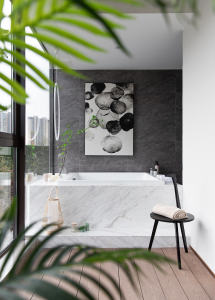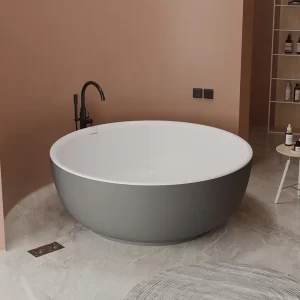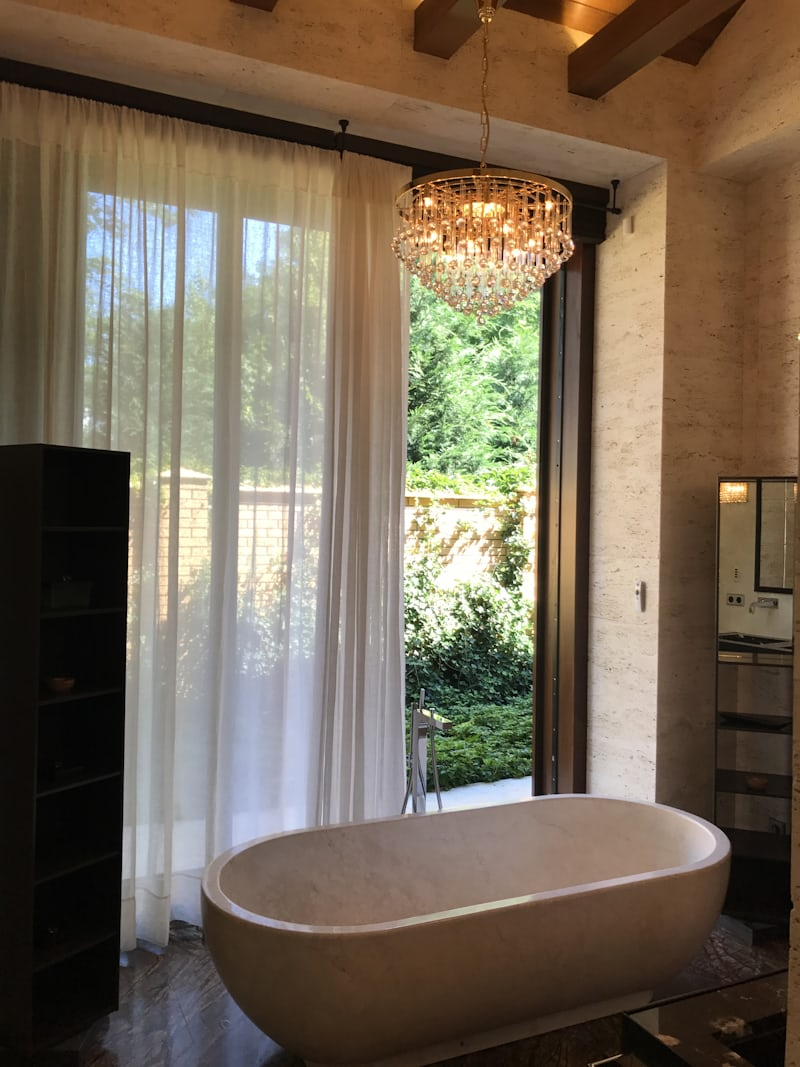Bathing is one of the oldest ways to relax in human history. As a bathing medium, bathtubs have naturally evolved from wood, copper, ceramics to various modern materials. But lately, in many people’s homes or upscale spas, an old but modern choice – natural stone bathtubs – has progressively become a “net celebrity item”. So, in addition to the luxurious appearance, can these stones directly collected from nature really bring a unique bathing experience? Today we will concentrate on how the thermal conductivity of natural stone bathtubs influences your bathing comfort. Bathing is, after all, a spiritual relaxation as well as a bodily purification; therefore, the performance of heat conductivity usually defines this comfort.

Natural stone bathtubs offer a unique bathing experience
Thermal conductivity characteristics of natural stone bathtubs
1. Stone thermal conductivity: a harmony between cold and warmth
A notable feature of natural stone is its thermal conductivity. Stone lacks rapid heat conductivity unlike most metals. This doesn’t seem like a good thing at first glance as, especially in winter, the cool touch of a stone bathtub will cause you to momentarily rethink whether you have made a “cold” decision.
But don’t worry, this initial coolness is only temporary. Although natural stone conducts heat more slowly than metal, this is precisely one of its advantages: once the stone is heated by warm water, it will remain warm for a long time, rather than dissipating heat quickly like metal. Therefore, even if you first contact it seems cold, the heat storing qualities of the stone will help to make the whole bathing process more pleasant and enable the water temperature to be maintained for a longer period.
2. Differences in stone types and thermal conductivity
Different types of natural stone have different thermal conductivity properties. One of the usually used materials is marble. Although its thermal conductivity is low, its beautiful look and smooth, delicate feel balance out this. In contrast, granite has a slightly higher thermal conductivity, which can absorb heat from the water faster and heat the surface slightly more quickly. Granite bathtubs so improve in preserving warm water effects.
Therefore, when you choose a natural stone bathtub, in addition to aesthetics, the thermal conductivity of the stone is also a key factor. If you want a longer warm bathing experience, a stone like granite may be a good choice, while if you are more concerned about the look and feel of the bathtub, marble may be more suitable.
3. The relationship between thickness and thermal conductivity
Another factor that affects the thermal conductivity efficiency of natural stone bathtubs is the thickness of the stone. Thicker stones will generally conduct heat more slowly, which implies that the bathtub surface will heat up more slowly as well; once heated, though, it will remain warm longer. Consequently, one should strike a compromise between heat conductivity and thickness. If you prefer a long bathing experience, thicker stones may be the best choice, allowing you to enjoy a longer-lasting warmth in the bathtub instead of rushing to end the bath because the water temperature drops quickly.

Natural stone bathtubs are beautiful and durable
The actual impact of thermal conductivity on the bathing experience
1. Initial coolness: How to deal with it?
For users of natural stone bathtubs, one of the most commonly mentioned feelings is “cold” when they first touch it. Stone will seem cooler first touch than other materials like acrylic or ceramic since it has a larger density and conducts heat more slowly.
So, how to deal with this “cold”? As it turns out, it’s really straightforward. Just forward warming of the bathtub. For example, you can take a hot shower for a few minutes or let the hot water stay in the bathtub for a while. The surface of the stone will soon begin to absorb heat and become warm and comfortable. Apart from making you feel cold, the preheated natural stone bathtub will let you enjoy the long-lasting warmth akin to a hot spring.
2. Lasting warmth: a great way to save water and electricity
A natural stone bathtub is surely a great choice for those who enjoy long baths. Because stone can retain heat for a long time, the water temperature will drop much slower during the bath than in a bathtub made of other materials. This not only lets you enjoy a longer warm water bath but also lessens the requirement of routinely reheating the water.
This also helps save energy. You can imagine that in an ordinary bathtub, the water needs to be reheated every once in a while, but a natural stone bathtub can effectively retain heat, reducing the demand for hot water, thereby saving water and electricity expenses. This long warm bath is ecologically friendly and very cheap.
3. Psychological relaxation effect
Although the heat conduction rate of natural stone bathtubs is slow, when it reaches the right temperature, the natural heat emitted by the stone can bring a deep sense of relaxation. This sensation results from the water’s warmth as well as from the stone’s actual touch. People feel more steady and comfortable in the stone because of its weight and natural texture, which like embrace nature.
The warm touch of the natural stone bathtub can improve the whole bathing experience and assist you to release the daily tiredness for people who seek the best relaxing experience. This dual enjoyment of mind and body is difficult to provide with other materials.
Maintenance of natural stone bathtubs and maintenance of thermal efficiency
1. Maintain the smoothness of the stone
In order to maximize the thermal efficiency of natural stone bathtubs, it is crucial to maintain the smoothness of the stone surface. Should dirt or water stains on the stone surface, it could compromise its heating and insulating impact as the smooth surface can better absorb and conduct heat.
Therefore, cleaning the bathtub regularly and keeping the stone surface dust-free and dirt-free can not only extend the service life of the bathtub, but also ensure that you can enjoy the lasting warmth every time you take a bath.
2. Prevent cracks and damage
Natural stone needs to be kept from cracking or damage even though it is robust and resilient. Particularly in cases of minor surface fissures in the stone, water could seep into it, therefore influencing the bathtub’s total insulating capacity. Therefore, regularly checking the surface of the stone and repairing possible cracks in time are important steps to maintain its thermal efficiency.

The warm touch of a natural stone bathtub can enhance the overall bathing experience
The natural stone bathtub adds a fresh perspective to the bathing experience with its special heat conduction qualities and opulent texture. Although it may feel a little cold at first, once heated, it can stay warm for a long time and bring a deep sense of relaxation connected to nature. In long-term usage, this slow but long-lasting thermal impact not only increases bathing comfort but also helps to save water and electricity costs. The natural stone bathtub is not only a visual enjoyment, but also a double pleasure of touch and psychology. A natural stone bathtub could be your finest option if you want a lovely and useful bathtub.





